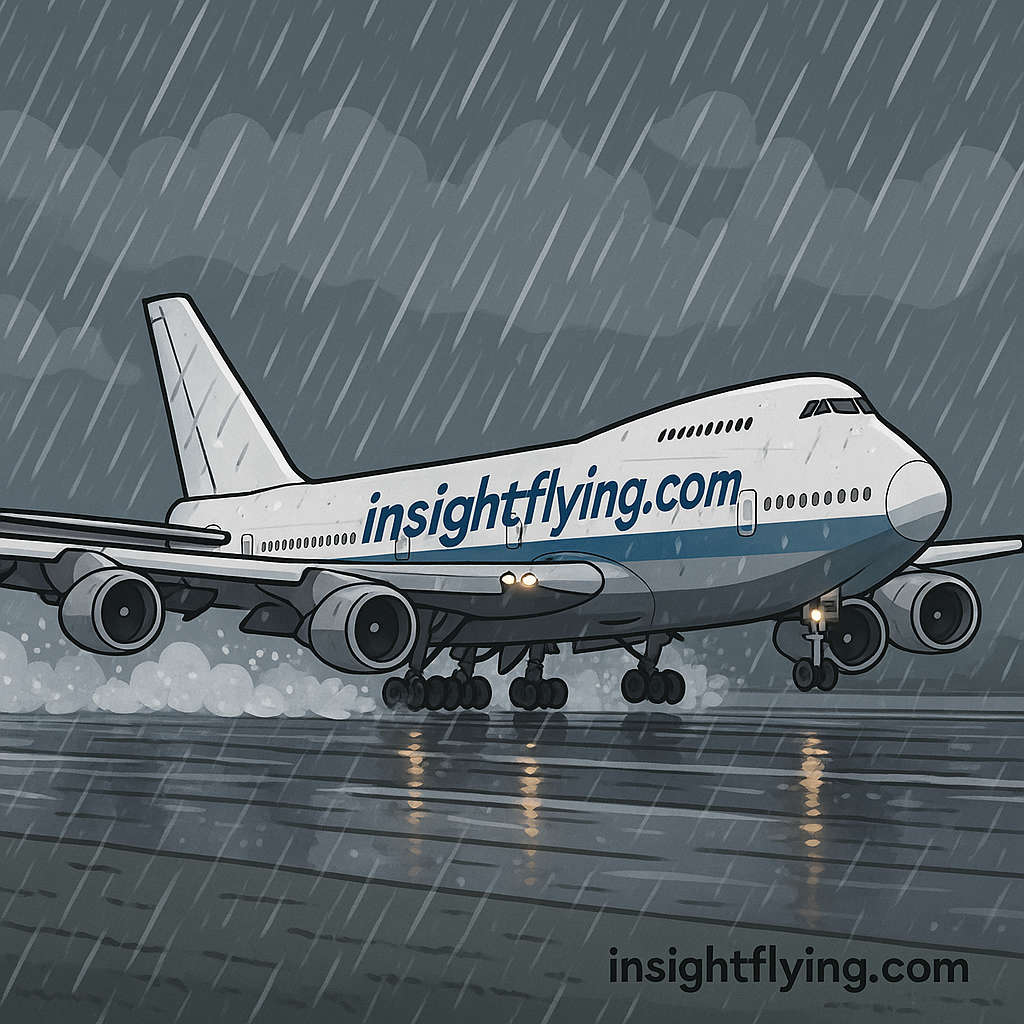(พื้นรันเวย์เปียก และการไถลไปทั้งตัว)
พื้นรันเวย์เปียกคืออะไร
พื้นเปียกก็ลื่นเป็นเรื่องธรรมดา เรามักคุ้นกับคำว่า “Slippery when wet” อยู่บ่อย ๆ สำหรับสนามบินก็เช่นกัน หากพื้นรันเวย์เปียก (Wet Runway) จะส่งผลให้ประสิทธิภาพการเบรคลดลง สนามบินหลายแห่งจึงทำร่องบนพื้นรันเวย์ (Grooved Runway Pavement) เพื่อช่วยรีดน้ำและเพิ่มประสิทธิภาพการเบรค
👉 อ่านเพิ่มเติม: Runway and Landing Operations
Wet pavement is naturally slippery — that’s why we often see signs like “Slippery when wet.” At airports, a Wet Runway can reduce braking effectiveness. To improve safety, many runways are designed with grooves (Grooved Runway Pavement) to channel water away and enhance braking efficiency.
👉 Related: Runway & Aircraft Performance
ระบบป้องกันการล้อล็อค (Anti-Skid System)
เครื่องบินมีระบบป้องกันการล้อล็อค เรียกว่า Anti-Skid System ทำหน้าที่ไม่ให้ล้อหยุดหมุนจนลื่นไถลไป และยังช่วยให้การเบรคแต่ละล้อทำงานสอดคล้องกัน ยางล้อของเครื่องบินมีจำนวนมาก เช่น B747 มีถึง 5 ชุด Landing Gear และในบางรุ่นอย่าง B777 หรือ A380 หนึ่งชุดมีถึง 6 ล้อ เพื่อกระจายน้ำหนักมหาศาลของเครื่องบิน
👉 อ่านเรื่อง Landing Gear System: Aircraft Basics
Aircraft use an Anti-Skid System to prevent wheel lock-up, ensuring smoother and safer braking. Each landing gear unit can have multiple wheels — for example, the Boeing 747 has 5 landing gear assemblies, while the Boeing 777 and Airbus A380 feature 6 wheels per assembly. This design distributes the massive weight and improves braking performance.
👉 Explore: Aircraft Landing Gear Explained
อุปกรณ์ช่วยลดความเร็ว
นอกจากเบรคแล้วยังมีระบบช่วยอื่น ๆ เช่น
- Engine Reverser: ทำหน้าที่เปลี่ยนแรงขับย้อนกลับ ช่วยชะลอความเร็ว
- SpeedBrake / Ground Spoiler: ลดแรงยกบนปีก เพิ่มแรงกดที่ล้อ ทำให้แรงเสียดทานกับพื้นรันเวย์มากขึ้น
👉 แนะนำให้อ่านเพิ่มเติม: Engine Reverser Explained – SKYbrary
Apart from brakes, airplanes are equipped with additional deceleration devices:
- Engine Reverser: Redirects thrust forward to reduce speed.
- SpeedBrake / Ground Spoiler: Reduces lift and pushes the aircraft more firmly onto the runway, increasing friction for better braking.
👉 See more: Ground Spoilers & Braking
Hydroplaning – การไถลไปทั้งตัว
หากน้ำฝนสะสมบนรันเวย์มาก อาจเกิดฟิล์มน้ำบาง ๆ ระหว่างยางกับพื้น ทำให้ล้อไม่สัมผัสพื้นจริง ๆ ส่งผลให้แรงเสียดทานหายไป แม้เบรคเต็มแรงก็ไม่ช่วยให้ลดความเร็วได้ เครื่องบินจะไถลไปตามแรงที่มีอยู่ ปรากฏการณ์นี้เรียกว่า Hydroplaning หรือ Aquaplaning
👉 ข้อมูลเชิงลึก: FAA – Runway Safety
When heavy rain covers the runway, a thin film of water can form between the tires and surface, preventing proper friction. Even with maximum braking, the aircraft won’t slow down — instead, it will continue sliding in the direction of motion. This phenomenon is known as Hydroplaning (or Aquaplaning).
👉 Related article: Hydroplaning in Aviation
สูตรคำนวณ Hydroplaning Speed
มีสูตรที่ใช้ประมาณความเร็วที่ทำให้เกิด Hydroplaning:
- Takeoff: 9√(tire pressure in psi)
- Landing: 7.7√(tire pressure in psi)
สองสูตรนี้ต่างกันเพราะเงื่อนไขการสัมผัสพื้นไม่เหมือนกัน — ขณะ Takeoff ล้อยังอยู่บนพื้นตั้งแต่ความเร็ว 0 และมีน้ำหนักกดลงอย่างต่อเนื่อง ขณะ Landing เครื่องบินแตะพื้นด้วยความเร็วสูงแล้วจึงชะลอลง ทำให้โอกาสเกิด Hydroplaning แตกต่างกัน
👉 อ่านเพิ่ม: Aircraft Tire Pressure & Safety
There are formulas to estimate hydroplaning speed:
- Takeoff: 9√(tire pressure in psi)
- Landing: 7.7√(tire pressure in psi)
The difference lies in the initial conditions. During takeoff, wheels roll from zero speed under full aircraft weight. In landing, the aircraft touches down at high speed (120–160 knots), then gradually decelerates, affecting the dynamics of tire-water interaction.
👉 Reference: NASA – Hydroplaning Studies
รถยนต์ก็ไถลได้เหมือนกัน
รถยนต์ก็สามารถเกิด Hydroplaning ได้เช่นเดียวกับเครื่องบิน โดยใช้สูตร 9√(tire pressure) เช่นกัน แต่รถยนต์ไม่มีตัวช่วยอย่าง Engine Reverser หรือ Ground Spoilers จึงหยุดได้ยากกว่ามาก ต้องรอให้รถพ้นจากฟิล์มน้ำบาง ๆ ก่อนถึงจะควบคุมได้อีกครั้ง
👉 บทความที่เกี่ยวข้อง: Driving Safety in Rain
Cars can also hydroplane, calculated with the same formula (9√tire pressure). Unlike aircraft, cars lack systems like Engine Reversers or Ground Spoilers, making recovery more difficult. Often, the car must slide out of the water film before regaining traction.
👉 Related topic: Hydroplaning Prevention
✅ สุดท้ายนี้: Drive Safe, Fly Safer
👉 ติดตามบทความอื่น ๆ ได้ที่ InsightFlying.com
หนังสือการบิน ทางลัดสู่ความเข้าใจที่นำไปใช้งานจริง

|
|

|
|

|
|

|
|

|
|
ขายดีที่สุด

|
|
